Does the timing of cluster halving impact grape and wine quality in Nebbiolo? (2023)
Preston Thomas
Stone Tower Winery
Summary
Stone Tower Winery has several acres of Nebbiolo that is used to produce a varietal wine. Without judicious crop thinning, these vines produce a heavy crop load with very large clusters. Typically, the crop is thinned at veraison by removing roughly half of each cluster, allowing better cluster morphology and, presumably, more even ripening. However, this comes at considerable cost in labor and yield. The purpose of this experiment was to (1) validate the efficacy of cluster halving and (2) test the impact of this treatment at two time points (post fruit set vs veraison). Three long rows of Nebbiolo were treated as control (no thinning), T1 (thinning by cluster halving between fruit set and bunch closure) and T2 (thinning by cluster halving at veraison). Fruit chemistry during ripening was very similar between early vs. late thinned fruit. Control fruit lagged behind with higher berry weight, lower Brix, and lower pH at two sampling dates. Finished wine chemistry was also very similar between the two treatments. Both had indications of riper fruit than the control, such as higher alcohol, higher pH and lower TA. Both treatment wines also had higher concentration of anthocyanins and phenolics, but lower tannin, than the control wine. The control wine and T2 (later thinning) wines had very similar sensory scores. The wine produced from early thinned fruit had significantly higher sensory scores for color intensity, hue, and fruit intensity. Early fruit thinning resulted in 22% lower yield while later thinning resulted in 37% lower yield than control. In this case, lower yield correlated with advanced ripening in both treatments and improved sensory results in the early thinned treatment.
Introduction
Nebbiolo at Stone Tower is very productive, routinely setting 3 large clusters per shoot and, if not mitigated, yielding 15-22 tons of fruit total (over 6 tons/acre). In this condition, the inside berries in the cluster do not fully ripen. Historically, management has included aggressive crop thinning at veraison, including the removal of roughly half of the grape cluster.
For varieties like Nebbiolo that have fruitful buds and large clusters, crop management by shoot thinning is often not sufficient. Cluster thinning may improve several aspects of berry chemistry including soluble solids (sugars), anthocyanins, and aroma compounds that contribute to varietal character. The timing of cluster thinning may affect its impact on fruit quality. If clusters are removed prior to bloom, it may result in vine compensation leading to larger clusters. If fruit is removed too soon after fruit set, increases in berry size may lead to larger, more compact clusters. But, waiting too long may limit the impact on grape ripening. In his Wine Grape Production Guide for Eastern North America1, Tony Wolf recommends thinning 4-6 weeks after bloom to minimize compensation and maximize the benefits of cluster thinning.
In this experiment, three treatments were employed:
Control: No cluster thinning
Treatment 1 (Early): Cluster thinning between fruit set and bunch closure
Treatment 2 (Late): Cluster thinning at veraison
Methods
A 2-acre block of Nebbiolo consisting of three very long rows of the same clone and rootstock was used for this experiment. The middle row was kept as a control with no fruit thinning. In the first row, clusters were halved on June 13, between fruit set and bunch closure (T1). In the third row, clusters were halved at veriason in early August (T2)(Figure 1). Fruit samples were collected separately from each row on Aug 31 and again on Sept 11. Fruit was harvested on Sept 13, with each row kept separate for winemaking.
For each treatment, fruit was destemmed to TBin, then inoculated with 24 g/hL BRL97 yeast. Must was chaptalized to a target of 23.5°Brix (total) at ⅓ sugar drop. Fermaid O was added during fermentation to a target of 150 ppm YAN. To manage temperature, TBins were moved outside during the day and into a cold box overnight. Wine was pressed after the completion of fermentation, allowed to settle for 4 days, then transferred to barrels for malolactic fermentation. Wine was inoculated with VP41 at the time of transfer. The progress of malolactic fermentation was monitored using OenoFoss analysis. At the completion of malolactic fermentation, 50 ppm SO2 was added without racking. Free SO2 was monitored monthly to maintain a target free SO2 of 30 ppm, with 20 ppm SO2 added in late January.
Sensory analysis was completed by a panel of 31 wine producers. Wines were presented blind in randomly numbered glasses. Tasters were presented with three different wines (control, T1, T2). Tasters were then asked to score each wine on a scale of 0 to 10 for color intensity, color hue (from red/brown through true red to red/blue), fruit intensity, fruit character (bright/fresh/red to dark/dried/black), intensity of astringency and overall perception of ripeness. They were also given open ended questions to describe the wines. There were four tasting groups with the order of analysis balanced among groups. Descriptive scores were analyzed using repeated measures ANOVA. If significant differences were found among descriptive scores, Tukey’s test was used to determine which categories were significantly different from one another. Tasters were also given 4 different fabrics as tactile standards (in order from softest to roughest; soft suede, velvet, sandpaper and burlap) and were asked to select the fabric that most closely represented the astringency of the wine. Fabrics were chosen to include an increasingly rough tactile perception.
Results
Cluster halving led to a more “natural” cluster morphology, with more space for berries to develop (Preston Thomas, personal communication)(Figure 1). There were some notable differences in berry characteristics during ripening. Control vines (that received no thinning) had larger berries (>100 mg increase), lower Brix (1-2° decrease), and lower pH (0.1 unit decrease) during ripening (Figure 2). Fruit from the row that was thinned at veraison (T2) had slightly lower berry weight, slightly higher Brix, and comparable measures of acidity to fruit that was thinned pre-veraison.
Figure 1: Nebbiolo clusters from three thinning treatments, photo was taken post veraison
(photo: Preston Thomas)
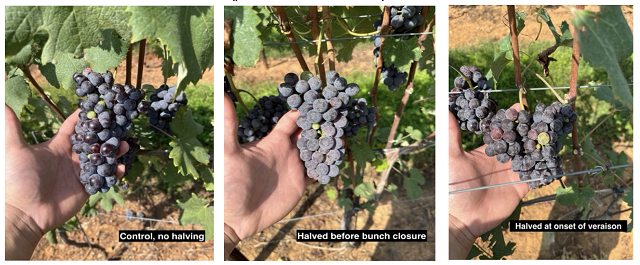
Figure 2: Fruit sampling for three treatments of Nebbiolo (in-house)
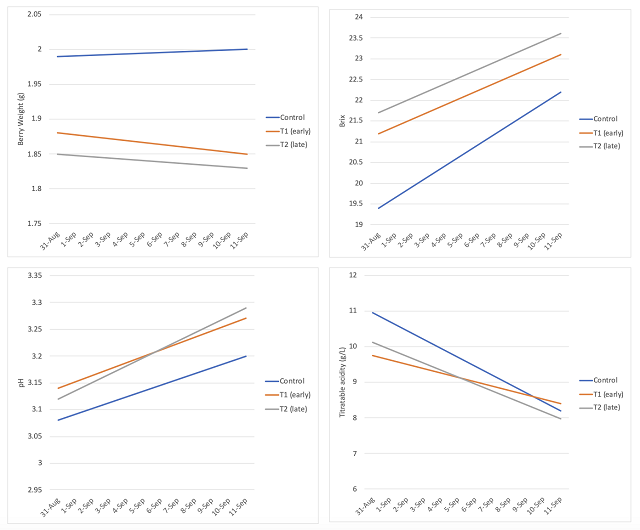
Fruit was harvested on September 13. Must from both of the thinned rows (T1 and T2) showed characteristics associated with higher levels of ripeness (higher Brix, lower acidity, higher pH) than the control, with fruit thinned at veraison appearing the most ripe (Table 1). Though the rows were the same length and thinned under the same regime, thinning at veraison resulted in lower crop yield than either the control or early thinning treatments (Table 1), likely due to lower berry weight (Figure 2). There was a 37% reduction in yield between control and T2.
Table 1: Fruit chemistry at harvest (In house values, Imbibe Solutions, Sept 14, 2023)

All three treatments finished fermentation with <1 g/L glucose/fructose and <0.15 g/L malic acid (data not shown). The Brix difference at harvest translated to slightly higher alcohol in both the treatment wines vs. control, but there was little different in alcohol between the thinning treatments. Wines from treated vines had higher pH (by 0.1 unit), indicating a slightly higher level of ripeness (Table 2). At the time samples were taken for wine chemistry, free SO2 values were very different between the wines, so color comparison could not be made.
Table 2: Post-malolactic wine chemistry (ICV Labs, Dec 2023)

Thinning treatment, whether early or late, produced wines with notably higher monomeric and total anthocyanin content, though this did not translate to higher polymeric anthocyanins (Table 3, Figure 3).
Table 3: Anthocyanin concentration (mg/L) in three treatments of Nebbiolo (ETS Labs)

Figure 3: Anthocyanin concentration (mg/L) in three treatments of Nebbiolo (ETS Labs)
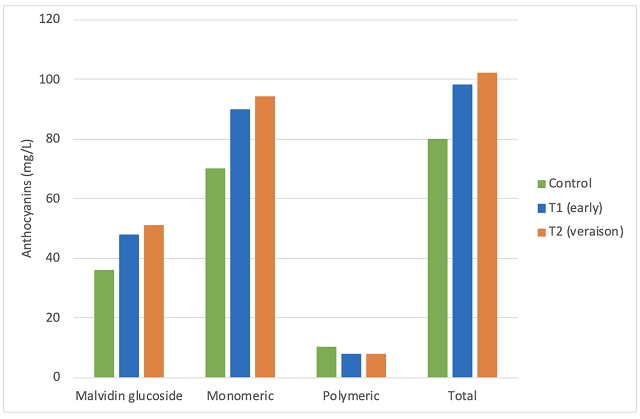
Overall concentration of phenolic compounds was also higher in the treated vs. control wines (Table 4, Figure 4), including both skin and seed phenolics, but not tannins. Tannin content in all three wines was low relative to published norms. Generally, seed phenolics become less extractable with ripeness2, so the increase in seed phenolics with thinning treatment was not expected. Phenolic compounds are also more extractable with higher alcohol, which may offset the phenolic differences due to ripeness.
Table 4: Skin and seed phenolics (mg/L) in three treatments of Nebbiolo (ETS Labs)

Figure 4: Skin and seed phenolics (mg/L) in three treatments of Nebbiolo (ETS Labs)
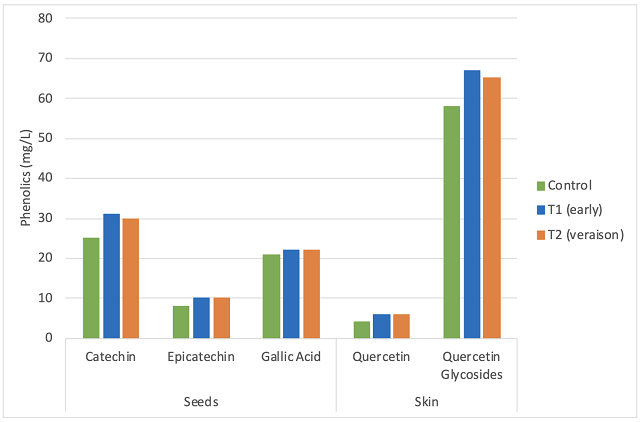
Sensory analysis produced significant differences in color intensity, color hue, fruit intensity, and the perception of ripeness among the wines, however, none of the pairwise comparisons were significant at the more stringent p-value of 0.05 (Table 5). If a less stringent p-value of 0.1 is allowed, then the early thinning treatment (T1) produced wine with higher color intensity, more red/blue hue (compared to red/brown) and higher fruit intensity (Figure 5).
Table 5: Repeated Measured ANOVA and Tukey's pairwise comparison for 3 treatments of Nebbiolo. C= control, T1= early, T2= veraison
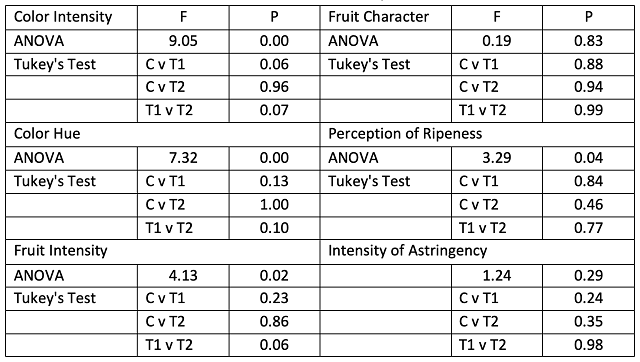
Figure 5: Descriptive scores for three treatments of Nebbiolo
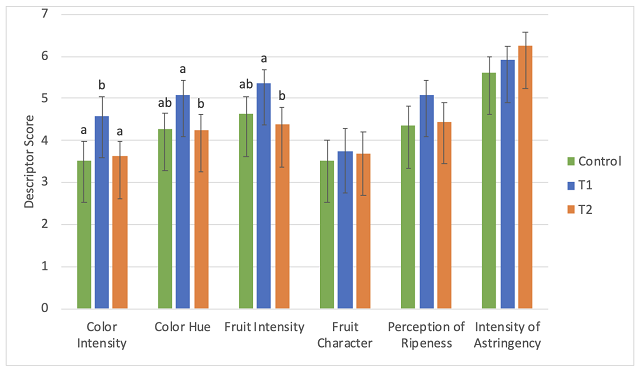
References
(1) Wolf, T. K. Wine Grape Production Guide for Eastern North America; Plant and Life Sciences Publishing: Ithaca, New York, 2008.
(2) Price, S. F. Phenolic Maturation in Grapes Including Frequently Asked Questions and Some Virginia Case Studies, 2023.
